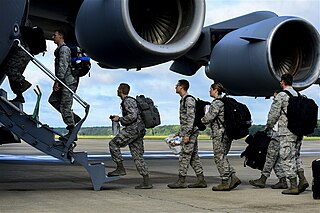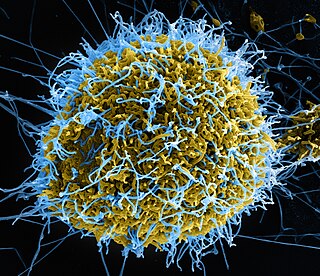
A quarantine is used to separate and restrict the movement of people; it is a "restraint upon the activities or communication of persons or the transport of goods designed to prevent the spread of disease or pests," for a certain period of time. This is often used in connection to disease and illness, such as those who may possibly have been exposed to a communicable disease, but do not have a confirmed medical diagnosis. The term is often erroneously used to mean medical isolation, which is "to separate ill persons who have a communicable disease from those who are healthy," and refers to patients whose diagnosis has been confirmed.

Bushmeat, wildmeat, or game meat is meat from non-domesticated mammals, reptiles, amphibians and birds hunted for food in tropical forests. Commercial harvesting and the trade of wildlife is considered a threat to biodiversity.

Cordon sanitaire is a French phrase that, literally translated, means "sanitary cordon". It originally denoted a barrier implemented to stop the spread of infectious diseases. It may be used interchangeably with the term "quarantine", and although the terms are related, cordon sanitaire refers to the restriction of movement of people into or out of a defined geographic area, such as a community. The term is also often used metaphorically, in English, to refer to attempts to prevent the spread of an ideology deemed unwanted or dangerous, such as the containment policy adopted by George F. Kennan against the Soviet Union.

The Hot Zone: A Terrifying True Story is a best-selling 1994 nonfiction thriller by Richard Preston about the origins and incidents involving viral hemorrhagic fevers, particularly ebolaviruses and marburgviruses. The basis of the book was Preston's 1992 New Yorker article "Crisis in the Hot Zone".

Yambuku is a small village in Mongala Province in northern Democratic Republic of the Congo, best known as the center of the 1976 Ebola outbreak. It is 1,098 kilometres (682 mi) northeast of the capital city of Kinshasa. The village has no running water or electricity. There is a hospital, but it has no radio, phone, or ambulances, and communication is done by motorbike messenger.
The Center for Infectious Disease Research and Policy (CIDRAP) is a center within the University of Minnesota that focuses on addressing public health preparedness and emerging infectious disease response. It was founded in 2001 by Michael Osterholm, PhD, MPH, in order to "prevent illness and death from infectious diseases through epidemiological research and rapid translation of scientific information into real-world practical applications and solutions".

The most widespread outbreak of Ebola virus disease (EVD) in history began in 2013 and continued until 2016, causing major loss of life and socioeconomic disruption in the West African region, mainly in the countries of Guinea, Liberia, and Sierra Leone. The first cases were recorded in Guinea in December 2013; later, the disease spread to neighboring Liberia and Sierra Leone, with minor outbreaks occurring elsewhere. It caused significant mortality, with the case fatality rate reported at slightly above 70%, while the rate among hospitalized patients was 57–59%. Small outbreaks occurred in Nigeria and Mali, and isolated cases were recorded in Senegal, the United Kingdom and Sardinia. In addition, imported cases led to secondary infection of medical workers in the United States and Spain but did not spread further. The number of cases peaked in October 2014 and then began to decline gradually, following the commitment of substantial international resources. As of 8 May 2016, the World Health Organization (WHO) and respective governments reported a total of 28,616 suspected cases and 11,310 deaths (39.5%), though the WHO believes that this substantially understates the magnitude of the outbreak.

An Ebola virus epidemic in Sierra Leone occurred in 2014, along with the neighbouring countries of Guinea and Liberia. On March 18, 2014 Guinean health officials announce the outbreak of a mysterious hemorrhagic fever "which strikes like lightning." It was identified as Ebola virus disease and spread to Sierra Leone by May 2014. The disease is thought to have originated when a child in a bat-hunting family contracted the disease in Guinea in December 2013. Consumption of African bushmeat, including rats, bats, and monkeys, is commonplace in Sierra Leone and West Africa in general.
Patrick Oliver Sawyer was a Liberian-American lawyer who was notable for being the index case for the introduction of Ebola virus disease into Nigeria during the West African Ebola epidemic. Sawyer was a naturalized U.S. citizen who lived in Coon Rapids, Minnesota. He has been variously described as working for the Liberian Ministry of Finance and for the mining company ArcelorMittal as their national manager for public health. He was aged 40 at the time of his death.

An epidemic of Ebola virus disease in Guinea represents the first ever outbreak of Ebola in a West African country. Previous outbreaks have been confined to several countries in Sub-Saharan Africa.

An epidemic of Ebola virus disease occurred in Liberia from 2014 to 2015, along with the neighbouring countries of Guinea and Sierra Leone. The first cases of virus were reported by late March 2014. The Ebola virus, a biosafety level four pathogen, is an RNA virus discovered in 1976.

In December 2014, Ebola virus cases in the United States occurred due to four laboratory-confirmed cases of Ebola virus disease in the United States. Eleven cases have been reported, including these four cases and seven cases medically evacuated from other countries; the first was reported in September 2014. Nine of the people contracted the disease outside the US and traveled into the country, either as regular airline passengers or as medical evacuees; of those nine, two died. Two people have contracted Ebola in the United States. Both were nurses who treated an Ebola patient; both have recovered.

This article covers the timeline of the 2014 Ebola virus epidemic in West Africa and its outbreaks elsewhere. Flag icons denote the first announcements of confirmed cases by the respective nation-states, their first deaths, and their first secondary transmissions, as well as relevant sessions and announcements of agencies such as the World Health Organization (WHO), the U.S. Centers for Disease Control (CDC), and NGOs such as Doctors Without Borders; medical evacuations, visa restrictions, border closures, quarantines, court rulings, and possible cases of zoonosis are also included.

Operation United Assistance is a 2014 United States military mission to help combat the Ebola virus epidemic in West Africa, including the part of the epidemic occurring in Liberia. The 101st Airborne Division headquarters was responsible for leading the mission.

Ebola virus disease in Mali occurred in October 2014, leading to concern about the possibility of an outbreak of Ebola in Mali. A child was brought from Guinea and died in the northwestern city of Kayes. Mali contact traced over 100 people who had contact with the child; tracing was completed in mid-November with no further cases discovered. In November, a second unrelated outbreak occurred in Mali's capital city, Bamako. Several people at a clinic are thought to have been infected by a man traveling from Guinea. On January 18 Mali was declared Ebola-free after 42 days with no new cases. There had been a cumulative total of eight cases with six deaths.
The following lists events that happened during 2014 in Sierra Leone.

Ebola virus disease in Nigeria occurred in 2014, a small part of the epidemic of Ebola virus disease beginning in Guinea that represented the first outbreak of the disease in a West African country. Previous outbreaks had been confined to countries in Central Africa.

Post-Ebola virus syndrome is a post-viral syndrome affecting those who have recovered from infection with Ebola. Symptoms include joint and muscle pain, eye problems, including blindness, various neurological problems, and other ailments, sometimes so severe that the person is unable to work. Although similar symptoms had been reported following previous outbreaks in the last 20 years, health professionals began using the term in 2014 when referring to a constellation of symptoms seen in people who had recovered from an acute attack of Ebola disease.
Dougbeh Chris Nyan is a Liberian medical doctor, a biomedical research scientist, social activist and inventor. He specializes in infectious disease research.


















